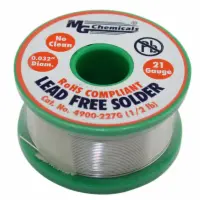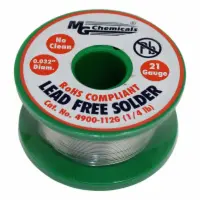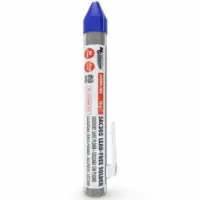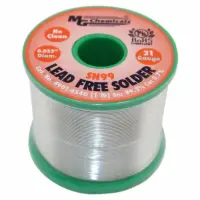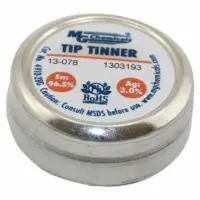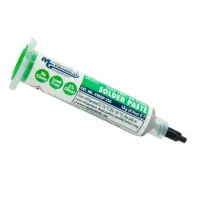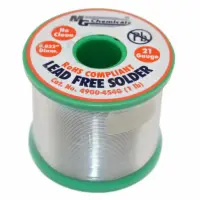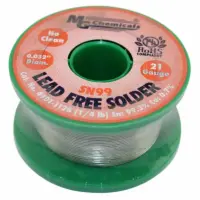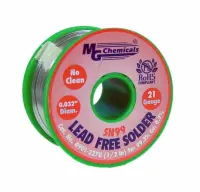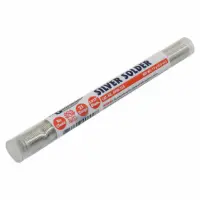Lead-Free Solder
Filters
Shop for lead-free solder, including Sn96 and Sn99 alloys, available in a variety of diameters and lengths. Our lead-free solder features excellent wettability and hard non-conductive residues.
We have spools of lead-free solder up to one pound as well as lead-free solder tubes. In addition, we carry solder tip tinner for repairing oxidized tips, optimizing the performance of your soldering equipment, and prolonging the life of new soldering iron tips.
What is Solder?
Solder (pronounced “sod-der” or “sole-der,” depending on where you are from) is a type of metal alloy that, under the right conditions, melts and joins two objects together. The act of melting solder to fuse surfaces together is called soldering.
What is Lead-Free Solder?
Originally, almost all solder had some form of lead because lead melted at lower temperatures and counteracted some of the negative effects of tin, which can form tin whiskers and eventually short-circuit or damage PCBs.
Lead-free solder was developed in the early 2000s to help industries move away from lead solders, which can be hazardous to health. These types of solders forgo lead and instead rely on higher concentrations of tin and the addition of alloys like copper and silver to achieve similar characteristics as lead solder.
Although safer than lead solders, lead-free solder melts at higher temperatures than lead solder and can lack some of the wettability and tensile strength that lead solder offers. Typically 60/40 tin-lead solder will become liquid at 361°F. The rule of thumb is the higher the tin content, the higher the melting point and product cost.
Unleaded Solder Uses
Lead free solder has a variety of applications, from soldering PCBs to making art. In most cases, lead-free solder can be used in place of lead solder, although you will need to make sure the soldering iron or equipment you are using can reach the high melting temperatures these types of solders require. Common lead-free solder uses include:
- Soldering circuit boards (also known as SMT soldering)
- Soldering stained glass
- Soldering jewelry
- Soldering in plumbing
It’s also important to review your local laws and regulations around lead solder. In some places, lead free solder is the only kind of composition you can use.
Additionally, any soldering projects that run the risk of infiltrating water supply or being too close to humans or animals should only use lead-free alloys. Furthermore, the area surrounding the soldering station should be equipped with a smoke absorber and well-ventilated.
Lead-Free Solder vs. Lead Solder
The key differences between lead-free and lead solder are the melting points, wettability, conductivity, price, and strength.
Lead Solder tends to be less expensive, more wettable, more conductive, and overall stronger than lead free solder. Lead solder also melts at (relatively) low temperatures. For example, Sn60 Pb40 (a common lead alloy) melts at 183°C or 361°F. Leaded solders are also eutectic, meaning they melt and solidify at a single temperature (not a temperature range)
Lead Free Solders often have higher tin concentrations than lead solder to help improve wettability and make up for the disadvantages of forgoing lead. This high tin concentration generally means lead free solder is more expensive. The main advantage to lead free solder is the absence of potential lead poisoning.
It’s no surprise why lead solder is often preferred over lead-free options. However, many governments and industries are working to move completely away from lead solder because of the detrimental health effects.
For this reason alone, it’s worth becoming familiar with lead-free solder and staying up to date on new compositions that might provide better wettability and lower melting points.
Lead Free Solder Types: Common Alloys & Composition
Although there are several compositions for lead free solder, the most common lead free allys for electrical soldering are tin-silver-copper (SnAgCu or SAC solder) and tin-copper (SnCu). Tin-silver-copper alloys (SAC solder) is ideal for soldering electronics and PCBs if lead solder is unavailable or undesired.
Solder compositions are often written with numbers to represent the percentages of each material. For example, solder made of 96.3% tin, 3% silver, and 0.7% copper would be written as Sn96.3 AG3 Cu0.7.
SnAgCu (tin-silver-copper) lead free solder alloys are popular for their low melting point (217 °C, 423 °F). Additionally, compositions high in silver (3% to 4%) can become true eutectic alloys that melt and solidify at the same temperatures. The silver also provides more mechanical strength than other lead free alloys, but may not be as wettable as alloys without silver. SAC solder compositions high in tin, like the Sn99/Ag0.3/Cu0.7, have better wettability. Overall, SAC or tin-silver-copper alloys are ideal for soldering SMT components.
SnCu (tin-copper) lead free solder alloys are also designed for soldering electronics, although it lacks some of the advantages of SnAgCu solders. For one, SnCu solder alloys are not as mechanically strong as SAC alloys (due to the lack of silver). Tin-copper alloys also melt at nearly 10°C higher than tin-silver-copper compositions. However, SnCu is a slightly more affordable option than SAC lead free alloys.

